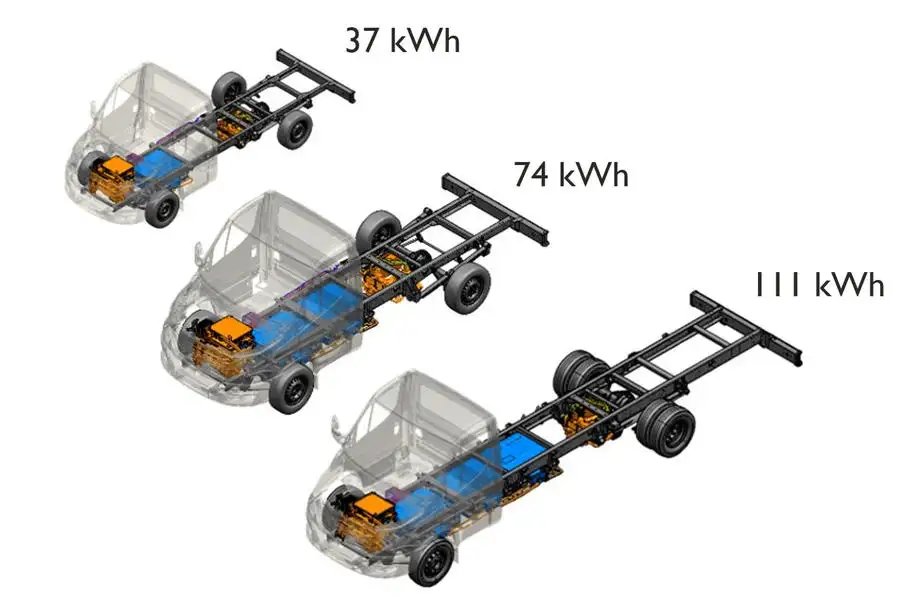Development of battery-swapping technology has largely centred around the idea of a swift, roadside battery swap for a quicker alternative to conventional charging, such as that pioneered by Chinese electric car maker Nio in its home country.
But commercial vehicle manufacturer Iveco has launched a new electric van that showcases a different use for an easily swapped, cassette-style battery. The Iveco e-Daily comes with the option of three battery sizes – 37, 74 and 111kWh, for WLTP ranges of between 74 and 217 miles – and it’s innovative for allowing users to retrospectively remove or add elements to the modular battery pack.
This can be hugely useful in various contexts, its creators say, but is most obviously of benefit in a commercial setting. If a van is being used as a last-mile delivery vehicle and doesn’t need a long range, the smaller battery would suffice, to keep costs and the environmental impact down as well as increase the maximum payload by removing battery weight of (in the Iveco’s case) 270kg per 37kWh li-ion pack.
But if the vehicle’s usage changes and a longer range would be useful, it can then be taken into one of Iveco’s servicing stations, where they can up the cell count to 74 or 110kWh. Similarly, cell packs can be removed if necessary, and swapped between the fleet’s vehicles as needed.
The process of swapping a battery pack in or out is expected to take around two hours and will need to be done at an Iveco service centre. This isn’t a swift roadside swap, but a system to allow flexibility of range and resources for a fleet.
A new cell pack will cost around £15,000 if required, plus labour costs. Iveco would offer money off in exchange for the old pack, although the actual remuneration would depend on the age and state of the battery.
The battery pack tech is provided by Chinese battery manufacturer Microvast. It uses a nickel-manganese-cobalt lithium ion cell chemistry similar to that already in use in many modern EVs but built into the modular packs that can be slotted in and out of the Iveco chassis. A warranty of 155,000 miles and eight years (100,000 miles on single-battery vehicles), with a performance guarantee of 80% – regardless of how often the 80kW DC rapid charging might be used – also suggests great confidence in the long-term performance of the cells.
“The system is quite unique to us,” explained Mike Cutts, business line director at Iveco. “We’ve developed it in-house. Our ladder-frame chassis is perfectly designed for that modularity – not just for [battery] electric but also for adaptation to hydrogen in the future.”
Iveco and Hyundai have partnered on hydrogen and other future projects, with Hyundai’s fuel cell tech already having been showcased in Iveco van and bus concepts – although neither firm has categorically suggested Iveco’s modular battery tech could make it into Hyundai’s passenger vehicles.
Cutts emphasised that there aren’t yet any plans to licence the technology: “It’s a unique feature to us, so we’d likely want to keep that in-house.”
Stephen Powell, alternative propulsion lead for Iveco, said the batteries have been designed to fit between the ladder-frame chassis. “But there’s no reason, in theory, why they couldn’t be designed to work with other platforms,” he added. “It would depend on the vehicle, be it passenger vehicle or otherwise, as long as it was designed around the modular batteries.”
The benefits of battery swapping
Iveco may be the first company to bring this sort of battery-swap technology to mass production in Europe, but others have been eyeing modular batteries for a while. As well as Nio, with its roadside swap, battery manufacturing giant CATL is another huge player to have recently announced a ‘module-to-bracket’ system aimed at trucks and construction machinery.
Wider use of cassette-style batteries could have a number of benefits. As Gavin Harper, critical materials research fellow at the University of Birmingham, said: “Given the pressure on critical materials resources, it makes a great deal of sense if a modular solution allows for right-sizing of the battery, and use of appropriate materials.
“If a battery can be swapped out, it opens up the potential for batteries using less energy-dense critical materials for some lower-duty applications, and more critical materials when ultimate performance is required.”
Another key benefit would include the easier removal of the batteries for recycling or reuse. Iveco already plans to make the most of this perk: it will offer second-hand batteries back to customers as a more affordable option, saving its customers money, and maximising the life of its batteries before they get repurposed for stationary energy storage or recycled.

